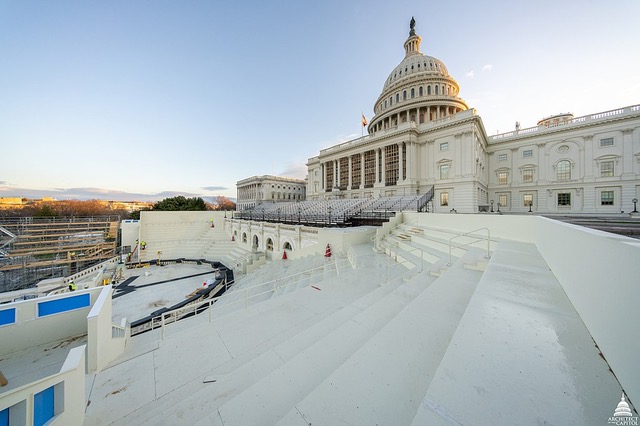Free tuition, bigger Pell grants, and more support for STEM research, healthcare, and broadband are among Biden administration policy plans that will, if enacted, strengthen tribal colleges and empower tribal nations.
By Melanie Lenart

Photo: Wikimedia Commons/Architect of the Capitol.
After a tumultuous couple of months, newly elected President Joe Biden and Vice President Kamala Harris are finally settling into the White House—thanks in part to crucial support from Indian Country.
“The Biden administration campaigned hard in Indian Country,” noted Patrese Atine, director of congressional/federal relations for the American Indian Higher Education Consortium. “You know, everybody has seen what happened in Arizona—tribes really showed up to vote this year.”
With indigenous voters submitting their ballots in record numbers, Arizona swung Democrat in the presidential election for only the second time since 1950. According to analysis by High Country News, Biden received support from an estimated 98 percent of voters from the Tohono O’odham Nation, whose citizens were enraged over former President Trump’s destruction of sacred land and burial grounds in his last-minute efforts to erect a wall within tribal nation’s lands, draining water from a treasured oasis in the process.
The Biden-Harris team also benefited from strong support from the Arizona portion of the Navajo Nation, where neglect and mismanagement by state Republicans and the outgoing Trump administration led to for some of the United States’ highest rates of Covid-19 transmission, argued Navajo Nation President Jonathan Nez.
Biden reciprocated in part by selecting New Mexico Rep. Deb Haaland, a citizen of Pueblo of Laguna, for the cabinet position of Interior Secretary, a move widely hailed in Indian Country. If confirmed, Haaland will be the first Native American to serve in a president’s Cabinet, hinting at a future where protecting sacred land and tribal water will take precedence over support for pipelines and border walls on sensitive lands. In 2016, Haaland traveled to Standing Rock Sioux’s Reservation in the Dakotas to support those protesting the Dakota Access pipeline, serving homemade stew and tortillas to those on the front lines.

“As one of the first Native American women elected to Congress, I have a unique perspective on the federal government’s trust and treaty responsibilities,” Haaland said. “The Biden-Harris Plan for Tribal Nations will honor those promises and have a profound positive impact on Indian Country.”
The plan, released on October 8 during a Phoenix visit with tribal leaders including from the Tohono O’odham and Navajo nations, takes on additional importance now that the Democrats won not only the executive branch but control of the Senate, the latter thanks to the two Senate seats captured in Jan. 5 runoffs in Georgia. With the Democrats retaining the House, they should have at least two good years to implement some of the policy items outlined in the plan.
Investments in Tribal Nations and TCUs
“On the Biden website, they have priorities for Indian Country,” Atine said. “Their statements for investments in Indian Country include Indian education, which include investments in tribal colleges. And that’s something they campaigned on. So yes, we’re hopeful, but I mean it’s going to take work from both sides.”
So what does the plan offer for tribal colleges and Native students? It seems to line up with many of the priorities identified by AIHEC in an October document for 2020 presidential candidates, including doubling Pell grants, shoring up TCU infrastructure, boosting support from funds relating the colleges’ land-grant status, and finding ways to speed up tribal internet connections, which have become a crucial component for learning as the pandemic continues to limit social interactions.
AIHEC hopes that these action items will be embraced as part of Biden’s larger education-focused agenda that includes providing free tuition at community colleges, including two-year tribal colleges, and forgiving some federal student loan debt.
Funding for students
Central to the plan are proposals for reducing the cost of higher education by lowering or eliminating tuition and canceling some student debt. Generally, these proposals apply for students whose family incomes are below $125,000, which the administration says covers about 90 percent of citizens of tribal nations. If enacted through legislation the plan would:
- Provide tuition-free access for most students, regardless of age, who attend a two-year tribal college, community college or other high-quality training program. Biden acknowledged this proposal originally came from one of his Democratic challengers, Sen. Bernie Sanders. The Biden Plan for Education Beyond High School suggests the federal government would cover 95% of this cost “for Indian Tribes operating community colleges serving low-income students.”
- Support tuition-free education for students attending four-year public colleges and universities, including land grant institutions.
- Double the maximum value of Pell grants, which help cover basic necessities for students attending college, such as food, clothing and transportation. Also, many higher education institutions tack on fees beyond tuition, so these grants can help cover those. When initiated in the 1970s, Pell grants covered more than two-thirds of tuition and fees, whereas now they typically cover less than a third, the plan states.
- Expand child care options among tribal nations, which will help the many parents who seek education to better the lives of themselves and their children. Along with finances, lack of child care is consistently cited by many TCU students as an impediment to their educational goals.
- Immediately cancel $10,000 in federal student loan debt during COVID-19, and forgive any tuition-related federal debt from two- and four- year public colleges for debt holders earning up to $125,000. Biden’s team acknowledged that his proposal originally came from an earlier presidential contender, Democratic Sen. Elizabeth Warren.
Funding for tribal colleges and universities
Stef Feldman, the Biden campaign’s national policy director, highlighted some plan details during an Oct. 22 webinar for Education Writers Association members. She and others in the administration include tribal colleges and universities under the category of MSI, for minority-serving institutions.
“Vice President Biden is also very focused on the fact that many of the inequities in our system are based on race, which is one of the reasons [he] has proposed to invest more than $70 billion in historically black colleges and universities and minority-serving institutions,” Feldman said.
“Some of that funding will go to setting up research hubs and incubators at those schools, so graduates of those schools are creating the next pipeline of diverse K-12 teachers, are coming up with the solutions to tackle climate change and cancer and so many of the other challenges we have,” added Feldman, who on Jan. 14 was appointed to the administration’s White House team on climate change.
With this in mind, the plan includes proposals to expand research and technology, including access to broadband at tribal colleges, as described briefly below. Some of the funding for these proposals are expected to come from dropping some tax breaks for wealthy Americans earning more than $400,000 a year and working to ensure that high-income earners actually do pay taxes. The items below are drawn from both the plan for tribal nations and the education plan.
- Invest more than $70 billion in MSIs and historically black colleges and universities, including in graduate health programs, and take other steps to recruit and train nursing professionals and other rural health care providers.
- Invest $5 billion in graduate programs in teaching, health care and STEM (Science, Technology, Engineering & Math) and develop robust internship and career pipelines for TCU students and other minorities at major research agencies, including the National Institutes of Health, the Department of Energy National Laboratories, and the National Science Foundation.
- Fund efforts to recruit and support Native teachers, including by helping students work toward their teaching certificates. The plan also calls for providing funding to TCUs to develop graduate programs in education.
- Help rectify funding disparities faced by tribal colleges by providing new funding to build research incubators, high tech labs, and digital infrastructure. The education plan calls for investing $10 billion to create 200 new centers of excellence that serve as research incubators and connect underrepresented students to learning and career opportunities in climate change, inequality, health disparities and cancer.
- Boost funding for agricultural research at land grant institutions, which includes most TCUs. Also, any research universities with an endowment greater than $1 billion will be required to form meaningful partnerships and subcontract with minority-serving institutions.
- Expand broadband, or wireless broadband via 5G, to every Native American household by investing $20 billion in rural broadband infrastructure. This will allow access to high-speed internet, which has been deemed crucial for modern education, especially in an ongoing pandemic.
- Partner with tribal nations, presumably including their TCUs, to identify and respond to the highest risks of climate change on tribal lands, restore the use of science and traditional ecological knowledge in planning for and adapting to climate change, and support tribal efforts to shift to clean energy production and use.
- Invest $10 billion in programs to increase enrollment, retention, completion and employment rates of students at TCUs and other minority-serving institutions. This could include supporting partnerships with high schools, other universities, and employers as well as evidence-based remedial courses and advising services.
- Triple and make permanent the support provided under Title III and Title V of the Higher Education Act. This would result in a dedicated revenue stream of $7.5 billion over the next 10 years for TCUs, historically black colleges and other MSIs.
“Disadvantaged communities,” including tribal communities, also are designated to receive at least 40 percent of a proposed $2 trillion investment in a clean energy future. So some of that would likely be available to tribal colleges and universities, either for research or for installing alternative energy features.
The Biden-Harris team also vows to reinstate the annual White House Tribal Nations Conference, something the occurred every year during the Obama-Biden administration but was dropped by Trump.
Now that Biden has started fulfilling his promise stated in the plan of ensuring “tribes have a seat at the table at the highest levels of federal government” by appointing Haaland to his Cabinet, and given that Democrats now control Congress as well as the executive branch, there is reasonable hope that at least some of the proposals outlined will become reality.
As Haaland shared with indianz.com in a statement in October: “From rebuilding the trust between the federal government and tribes through genuine tribal consultation and empowering Indian tribes through self-government, to expanding and protecting healthcare for millions of Native Americans, the Biden-Harris Plan for Tribal Nations respects our past and lays out a strong path forward for Indian Country.”
• • •
Melanie Lenart is a regular contributor to Native Science Report.
• • •
Enjoyed this story? Enter your email to receive notifications of new posts by email

This article articulated the new government to government relationship renewed by Biden and Harris. At last, tribes will be at the fore front. Important article for tribes.